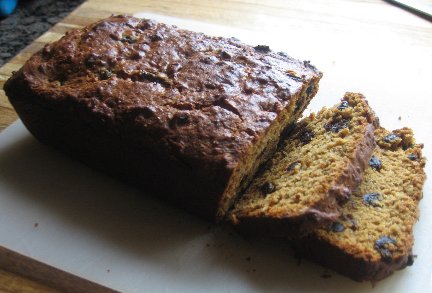As the name implies, quick breads can be made quickly and easily. Quick breads are called “quick” because they have to be baked or cooked immediately after being mixed. Because the leavening agent is either baking powder, baking soda, or steam, there is no rising time required.
A baked quick bread will generally have a gently rounded top that is slightly bumpy. Do not worry about a crack on top of the quick bread loaves; it is normal.
What is Quick Bread: It is any sweet or savory bread leavened with leavening agents other than yeast or eggs, but use baking powder and/or baking soda for the leavening agent. Quick breads include banana breads, biscuits, cornbread, muffins, popovers, coffeecakes, pancakes and waffles, scones, and soda bread.
Check out What’s Cooking America’s easy to make and delicious Quick Bread Recipes.
IMPORTANT: When working with baking powder or baking soda, do not beat the batter – stir only enough to just moisten the dry ingredients. There may still be lumps remaining in the dough, but this is okay. the more you mix a quick-bread batter, the more you develop the flour’s gluten, and the tougher the resulting bread.color.
Check to make sure your baking powers and baking soda are fresh. Check the expiration date on the packages before using.
Baking Powder: Do not increase the quantity of baking powder called for in a particular recipe, for too much leaves a distinctive and unpleasant taste. Measure ingredients accurately using the proper tools.
Baking Powder is a leavening agent that consists of a combination of baking soda, cream of tartar, and a moisture absorber (like cornstarch). It has the action of yeast, but it acts much more quickly.
When creating a recipe, the food chemistry rule is 1 to 1 1/4 teaspoons of baking powder per 1 cup flour. If too much baking powder is used in your recipe, this produces big bubbles that run into each other, rise to the surface and pop. There goes the leavening, and the result is that the muffins, cakes or quick breads become heavy or sunken.
Flour: Do not substitute self-rising or cake flour for all-purpose flour, unless you are confident of being able to calculate exactly how much to reduce the quantity of baking powder or baking soda to compensate.
Bake all quick breads as soon as the ingredients are assembled. Since high temperatures are often called for, it is best to bake them in the center of the oven, as the heat in the top third of the oven will be too intense. If your oven tends to overheat, reduce the oven temperature by 25 degrees and increase the cooking time by 5 minutes.
Baking Pans: Because glass bake ware retains heat better than metal bake ware, reduce the temperature of your oven by 25 degrees when using glass pans.
Baking Time – Internal Temperature: Bake until a toothpick inserted in the center comes out clean. A good check is to use an instant digital thermometer to test your bread. The internal temperature of the bread should be at 200 degrees F.
If you find that your bread is beginning to brown too fast, cover it with a tent of aluminum foil.
Bread Cooling Time: Cool quick breads in the loaf pan for 10 minutes; then remove from pan and allow to cool completely before slicing.
Cutting or Slicing: Use a sawing motion with your knife to cut the loaves. Use a serrated knife for slicing.
Storage: Breads that contain fruit, nuts, or butter may be stored for 2 or 3 days, well wrapped in plastic wrap or aluminum foil.
Freezing Quick Bread: Nearly all quick breads freeze well, but if kept for over a month they tend to become dry. After thawing frozen breads, reheat them in a 400 degree oven for a few minutes before serving.
Categories:
Cooking Hints & Tips

